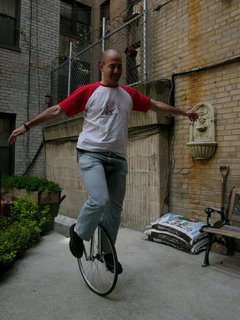Qu-Ax, Qu-Ax

I just bought a racing unicycle (which I will NOT be referring to as a 'runi'). It came from a member of the club who bought it recently and then quickly decided it wasn't practical for him. He only rode it five or six times.
The unicycle is a Qu-Ax brand 26", but it's made so that a thin tire allows it to meet the maximum racing dimensions. The rim and the tire are really thin (less than an inch in width), and the wheel is made to withstand really high pressure (it's at 110 psi). It feels like I'm riding on wheelchair rubber. That's great for a racing uni but not good for a ride-around-town unicycle. I'd be afraid to go up or down a curb on it. It's really light (I was told it's only about 8 pounds), and I'll make it lighter still by chopping off part of the seat post.
I only race a few days a year (at the annual convention), but I've always been envious of those who have really nice racing cycles. I've always done ok on whatever I rode in the past, which was usually either the 24" cheapo uni of mine or a slightly better unicycle that I might borrow from a friend. It's not that there are a lot of competitors in my age group. Many of the guys in the 30-39 enjoy competition for its own sake, as is true in any age category, but my group is a lot less competitive than the younger bucks. However, I've always liked racing, and ever since I was a kid, I've always done pretty well. This unicycle will only contribute to that. I'm curious to see what happens when I race in Tennessee this summer. I'll be racingnot only against my peers but also against my previous best times. Interestingly, I've actually gotten faster as I've gotten older, probably because my balance has improved and because I've done a great deal of riding lately (in my daily commuting), so my legs are probably a bit stronger.
In the meantime, I'll practice riding it at the Tomb so that I can work on my technique.



